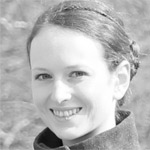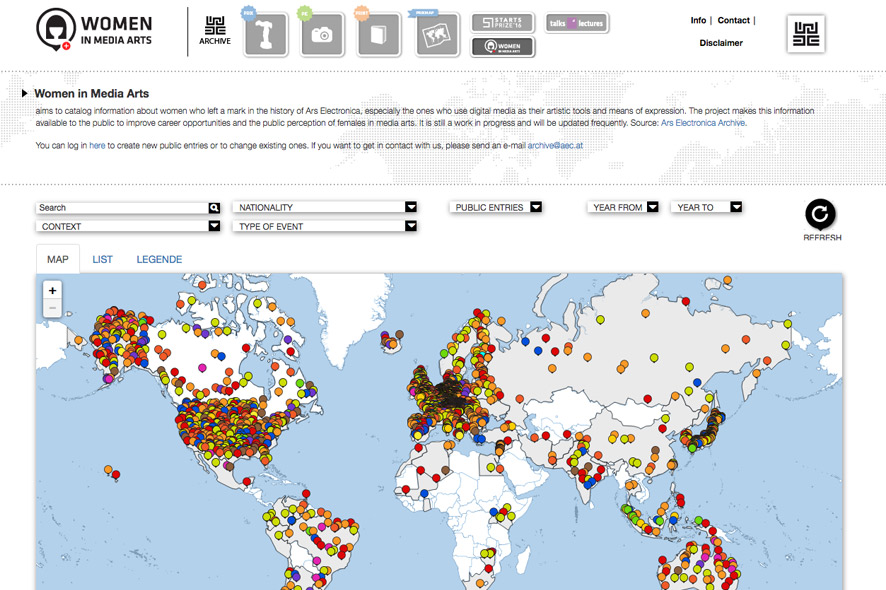Why has Ars Electronica set up the Women in Media Arts online database?
Florina Costamoling: The idea of establishing a database about women in media arts had already been proposed a few years ago as a means for us to specifically seek female artists as we went about organizing our exhibitions and conferences. The first phase entailed retrieving the necessary data from our archives—for the most part, manually—which is why it took a while to actually commence the implementation phase. That time came in early 2016; following about nine months of research in old festival catalogs, programs and websites, we were ready to present the first publically accessible version of the database at the 2016 Ars Electronica Festival.
Who comprise this database’s target audience?
Florina Costamoling: The database is meant to be used by artists, scholars, professors, curators and anyone else interested in the subject of women in media art. We hope that this tool will be used not only by us but also by other institutions and individuals to advance female artists and to give them opportunities—in exhibitions and speeches, for instance—to display their qualities and talents.
Now, it’s also possible for users to input their own entries.
Florina Costamoling: Right. We’ve expanded the database to include a publically accessible input module so that female artists can supplement their information. Plus, we want to provide an opportunity to women who haven’t yet been associated with Ars Electronica to present themselves on this platform. This database makes no claim to comprehensiveness but we’d like to make available the broadest possible spectrum of data so that they can also be used by interested scholars for research purposes.
How does this function and what sort of material can be input here?
Florina Costamoling: The site http://archive.aec.at/womeninmediaarts/ features a link to enable users to revise and expend the entries. A user who has set up an account—which is free of charge—can enter new information about female artists and their projects into the database, as well as revise existing publically accessible entries. Once the material entered has been checked and approved, it will be available in the Women in Media Arts Archive.
How big is the database at present, and what other such resources exist worldwide?
Florina Costamoling: We only just recently activated the feature that enables users to input information, so this is now publically available, and we cordially invite friends of Ars Electronica to participate in this project and to enter information about female media artists. At this point, Ars Electronica’s staff has set up the database with entries on over 1,800 women, which makes Women in Media Arts one of the world’s largest databases about female media artists. We’ve already contacted other institutions and initiatives that have implemented interesting projects for the advancement of women. Next, we’ll set up a list of links to these resources on our website.
You’ve managed this project right from its inception. So, what have you taken away from this experience?
Florina Costamoling: As we went about preparing the data, it was interesting to observe how female involvement changed over the years along with the festival as a whole. In 1979, there were hardly any women involved; in 2016, the proportion of female artists at the Ars Electronica Festival was at least 43%. In this respect, however, the database stakes no claim to comprehensiveness since we unfortunately no longer have complete data about all the artists who’ve ever participated in the Ars Electronica Festival. Incidentally, most of the feedback we’ve received has been about women for whom there are no entries at all in the database.
I hope that this possibility for users to enter information will enable us to give an account in our database of an even broader spectrum of women in media arts. But this database is conceived as just the first point of contact, a convenient way to perform an initial search, and that then facilitates the transition to in-depth research online. Numerous suggestions for improvement have already flowed into the enhancement of the database, and, needless to say, we’re looking forward to receiving more ideas. The best way to do this is via e-mail to archive@aec.at.

Florina Costamoling studied Time-based and Interactive Media at the Linz Art University and worked independently in the film production sector. Since 2015, she has been project manager at Ars Electronica in the FESTIVAL PRIX EXHIBITIONS area, where she has worked alongside the Women in Media Arts project for the exhibitions 1001 model (Ars Electronica Festival, 2015) and Human Factor, Endless Prototyping (DRIVE, Volkswagen Group Forum Berlin, 2016). Currently she is managing the STARTS Prize.
